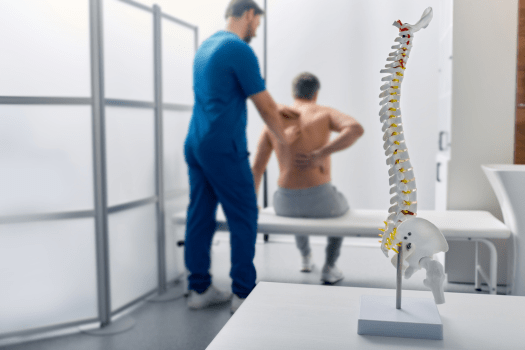
Exploring Lumbar Discectomy: A Surgical Solution for Spinal Disc Problems
A lumbar discectomy is a surgical procedure that removes part of a damaged disc in the lower spine. The disc is a cushion-like structure that sits between the vertebrae, the bones that make up the spine. The disc helps absorb shock, maintain flexibility, and protect the spinal cord and nerves.
Sometimes the disc can bulge or herniate out of its normal position and press on the spinal cord or nerves, causing pain, numbness, weakness, or tingling in the lower back and legs. A lumbar discectomy aims to relieve these symptoms by removing the part of the disc that is compressing the nerve. The procedure can be done in different ways, depending on the location and size of the herniation, the patient’s condition, and the surgeon’s preference.
If you have been suffering from chronic lower back pain or sciatica, understanding the approach and benefits of a lumbar discectomy can provide you with valuable insights. This article explains details about this procedure, offering you a clearer understanding of what to expect.
Most Common Approaches
Some of the common approaches for a lumbar discectomy are:
- Microdiscectomy – This is a minimally invasive technique that uses a small incision and a microscope to access and remove the herniated disc. The surgeon may also use special instruments to cut away any bone spurs or ligaments that are contributing to the nerve compression. This technique has less blood loss, less tissue damage, and faster recovery than open surgery.
- Endoscopic discectomy – This is another minimally invasive technique that uses a thin tube with a camera and light (endoscope) to guide the surgeon to the herniated disc. The surgeon inserts the endoscope through a small incision in the back and uses tiny instruments to remove the disc material. This technique has similar benefits as microdiscectomy but may have less risk of nerve injury or infection.
- Open discectomy – This is a traditional technique that uses a larger incision and more exposure of the spine to access and remove the herniated disc. The surgeon may also remove some bone or ligament to create more space for the nerve. This technique has more blood loss, more tissue damage, and longer recovery than minimally invasive techniques but may be necessary for some complex cases.
Factors Affecting the Approach for Lumbar Discectomy
The choice of approach for a lumbar discectomy depends on several factors, such as:
- The severity and duration of symptoms
- The location and size of the herniated disc
- The presence of other spinal conditions, such as spinal stenosis or spondylolisthesis
- The patient’s age, health, and lifestyle
- The surgeon’s experience and preference
A lumbar discectomy is usually performed under general anesthesia and takes about an hour to complete. The patient may need to stay in the hospital for one or two days after the surgery. Recovery time varies depending on the type of surgery and the patient’s condition but typically ranges from four to six weeks.
Recovery and Rehabilitation
Following a lumbar discectomy, you can expect the following during recovery:
- Postoperative pain management – After surgery, you may experience some pain, but your medical team will provide pain management options to keep you comfortable.
- Hospital stay – Depending on the specific procedure and your overall health, you may be discharged the same day or require a short hospital stay.
- Physical therapy – Physical therapy plays a crucial role in your recovery, helping you regain strength and flexibility in the lower back.
- Resuming normal activities – Your surgeon will provide guidelines on when you can return to work and engage in everyday activities.
- Long-term outlook – Most patients experience a significant reduction in pain and increased mobility following a successful lumbar discectomy. However, it is essential to follow your surgeon’s recommendations for a full recovery.
Benefits of Lumbar Discectomy
A lumbar discectomy can provide significant relief from pain and improve function for patients with lumbar disc herniation. However, as with any surgery, it has some risks and complications, such as:
- Bleeding
- Infection
- Nerve injury
- Spinal instability
- Recurrence of herniation
- Failed back surgery syndrome
Therefore, it is important to consult with a qualified spine surgeon before deciding to undergo a lumbar discectomy. The surgeon will evaluate your condition, explain your options, and recommend the best approach for you.
Post-discectomy pain levels and back surgery recovery time vary among individuals and depend on factors such as disc height and the size of the hole left in the outer ring of the disc after surgery. If the hole in the disc is larger than a standard pencil eraser, the patient has a significant risk of reherniation. Patients with a large hole in the outer ring of the disc are more than twice as likely to reherniate after surgery. These reherniationsoften require additional surgery or even a larger spinal fusion operation.Barricaid is a bone-anchored device shown to reduce reherniations by closing the hole in the disc after a discectomy, and 95 percent of Barricaid patients did not undergo a reoperation due to reherniation in a 2-year study timeframe. This treatment is done immediately following the discectomy—during the same operation—and does not require any additional incisions or time in the hospital.
If you have any questions about the Barricaid treatment or how to get access to Barricaid, you may ask your doctor or contact us at 844-288-7474.
For full benefit/risk information, please visit: https://www.barricaid.com/instructions.


Comments